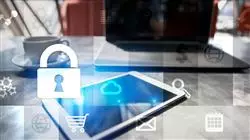University certificate
Scientific endorser

The world's largest faculty of information technology”
Introduction to the Program
As technology and connectivity advance, so do the number and form of potential threats. It is therefore crucial that future Chief Information Security Officers update their knowledge to offer solutions that are more adapted to the company's idiosyncrasies"
As technology advances, so do threats, perfecting their attack techniques. In other words, the possibilities and ways for cybercriminals to achieve their goals are growing. It is under this context that TECH presents a degree with which professionals will be able to catch up, learning in a comprehensive way to protect and secure various digital environments. All this, through a revolutionary methodology, the relearning; and in a comfortable and totally online format, which will allow graduates to acquire skills and abilities without a preset timing. As a result, at the end of this program, professionals will obtain the necessary skills and competencies to work with great efficiency as Chief Information Security Officer, a top management position with great prestige, as well as high prospects for growth and expansion.

It is no secret that we are in the midst of the information and communication era, as we are all connected both at home and in corporate environments. Therefore, we have access to a multitude of information with a single click, with a single search in any of the engines at our disposal, either from a Smartphone, personal or work computer.
As technology advances for the average citizen and employee, so do threats and attack techniques. The more new functionalities there are and the more communicated we are, the more the attack surface increases. Given this worrying context, TECH launches this Professional master’s degree in Cybersecurity Management (CISO, Chief Information Security Officer), which has been developed by a team with different professional profiles specialized in different sectors that combine international professional experience in the private sector in R+D+i and extensive teaching experience.
In addition, thisProfessional master’s degree provides students with excellent and complete extra lessons, taught by a specialist in Intelligence, Cybersecurity and Disruptive Technologies of international prestige. This innovative content will be accessible in the format of 10 exclusive Masterclasses, which will allow graduates to be updated in Cybersecurity and to lead the departments in charge of these tasks in the most important departments in charge of these tasks in the most important companies in the technology sector.
The program includes the different core subjects in the area of cybersecurity, carefully selected to cover, in a rigorous way, a wide spectrum of technologies applicable in the different fields of work. But it will also deal with another branch of subjects that are usually scarce in the academic catalog of other institutions and that will nourish other institutions and that will deeply nourish the professional's curriculum. In this way, and thanks to the transversal knowledge offered by TECH with this program, the graduate will acquire the skills to work as a manager in the area of cybersecurity (Chief Information Security Officer), thereby increasing their personal and professional growth prospects.
Prepare yourself with the best professionals! Take advantage of 10 Masterclasses taught by an internationally renowned teacher"
ThisProfessional master’s degree in Cybersecurity Management (CISO, Chief Information Security Officer) contains the most complete and up-to-date program on the market. The most important features include:
- The graphic, schematic and eminently practical contents with which it is conceived gather scientific and practical information on those disciplines that are indispensable for professional practice
- Practical exercises where self-assessment can be used to improve learning.
- Its special emphasis on innovative methodologies
- Theoretical lessons, questions to the expert, debate forums on controversial topics, and individual reflection assignments
- Content that is accessible from any fixed or portable device with an Internet connection
Stand out in a booming sector and become an expert in cybersecurity with this TECH MBA. It’s the most complete on the market”
The program's teaching staff includes professionals from the sector who contribute their work experience to this program, in addition to renowned specialists from leading societies and prestigious universities.
The multimedia content, developed with the latest educational technology, will provide the professional with situated and contextual learning, i.e., a simulated environment that will provide immersive education programmed to learn in real situations.
This program is designed around Problem-Based Learning, whereby the professional must try to solve the different professional practice situations that arise during the course. For this purpose, students will be assisted by an innovative interactive video system created by renowned and experienced experts.
The ways in which people exchange information are evolving rapidly. This demands new forms of cyber protection from professionals.

A 100% online program with an eminently practical approach that will lay the foundations for your professional growth.
Why study at TECH?
TECH is the world’s largest online university. With an impressive catalog of more than 14,000 university programs available in 11 languages, it is positioned as a leader in employability, with a 99% job placement rate. In addition, it relies on an enormous faculty of more than 6,000 professors of the highest international renown.

Study at the world's largest online university and guarantee your professional success. The future starts at TECH”
The world’s best online university according to FORBES
The prestigious Forbes magazine, specialized in business and finance, has highlighted TECH as “the world's best online university” This is what they have recently stated in an article in their digital edition in which they echo the success story of this institution, “thanks to the academic offer it provides, the selection of its teaching staff, and an innovative learning method aimed at educating the professionals of the future”
A revolutionary study method, a cutting-edge faculty and a practical focus: the key to TECH's success.
The most complete study plans on the university scene
TECH offers the most complete study plans on the university scene, with syllabuses that cover fundamental concepts and, at the same time, the main scientific advances in their specific scientific areas. In addition, these programs are continuously being updated to guarantee students the academic vanguard and the most in-demand professional skills. In this way, the university's qualifications provide its graduates with a significant advantage to propel their careers to success.
TECH offers the most comprehensive and intensive study plans on the current university scene.
A world-class teaching staff
TECH's teaching staff is made up of more than 6,000 professors with the highest international recognition. Professors, researchers and top executives of multinational companies, including Isaiah Covington, performance coach of the Boston Celtics; Magda Romanska, principal investigator at Harvard MetaLAB; Ignacio Wistumba, chairman of the department of translational molecular pathology at MD Anderson Cancer Center; and D.W. Pine, creative director of TIME magazine, among others.
Internationally renowned experts, specialized in different branches of Health, Technology, Communication and Business, form part of the TECH faculty.
A unique learning method
TECH is the first university to use Relearning in all its programs. It is the best online learning methodology, accredited with international teaching quality certifications, provided by prestigious educational agencies. In addition, this disruptive educational model is complemented with the “Case Method”, thereby setting up a unique online teaching strategy. Innovative teaching resources are also implemented, including detailed videos, infographics and interactive summaries.
TECH combines Relearning and the Case Method in all its university programs to guarantee excellent theoretical and practical learning, studying whenever and wherever you want.
The world's largest online university
TECH is the world’s largest online university. We are the largest educational institution, with the best and widest online educational catalog, one hundred percent online and covering the vast majority of areas of knowledge. We offer a large selection of our own degrees and accredited online undergraduate and postgraduate degrees. In total, more than 14,000 university degrees, in eleven different languages, make us the largest educational largest in the world.
TECH has the world's most extensive catalog of academic and official programs, available in more than 11 languages.
Google Premier Partner
The American technology giant has awarded TECH the Google Google Premier Partner badge. This award, which is only available to 3% of the world's companies, highlights the efficient, flexible and tailored experience that this university provides to students. The recognition as a Google Premier Partner not only accredits the maximum rigor, performance and investment in TECH's digital infrastructures, but also places this university as one of the world's leading technology companies.
Google has positioned TECH in the top 3% of the world's most important technology companies by awarding it its Google Premier Partner badge.
The official online university of the NBA
TECH is the official online university of the NBA. Thanks to our agreement with the biggest league in basketball, we offer our students exclusive university programs, as well as a wide variety of educational resources focused on the business of the league and other areas of the sports industry. Each program is made up of a uniquely designed syllabus and features exceptional guest hosts: professionals with a distinguished sports background who will offer their expertise on the most relevant topics.
TECH has been selected by the NBA, the world's top basketball league, as its official online university.
The top-rated university by its students
Students have positioned TECH as the world's top-rated university on the main review websites, with a highest rating of 4.9 out of 5, obtained from more than 1,000 reviews. These results consolidate TECH as the benchmark university institution at an international level, reflecting the excellence and positive impact of its educational model.” reflecting the excellence and positive impact of its educational model.”
TECH is the world’s top-rated university by its students.
Leaders in employability
TECH has managed to become the leading university in employability. 99% of its students obtain jobs in the academic field they have studied, within one year of completing any of the university's programs. A similar number achieve immediate career enhancement. All this thanks to a study methodology that bases its effectiveness on the acquisition of practical skills, which are absolutely necessary for professional development.
99% of TECH graduates find a job within a year of completing their studies.
Professional Master's Degree in Cybersecurity Management (CISO, Chief Information Security Officer)
In recent decades, technology has been immersed in most areas of life, creating a hyperconnected world between people, companies and / or organizations. The ability to improve connections of any type of information has generated the need to establish completely secure links, since it is increasingly common to witness in these digital spaces cyber-attack techniques or threats to user information. Understanding this context, in TECH Global University we designed a Professional Master's Degree in Cybersecurity Management (CISO, Chief Information Security Officer), which aims to understand the role of a cybersecurity analyst to recognize the systems, methods of threats and ways to avoid, reduce or solve the risks.
Study an online Professional Master's Degree in cybersecurity CISO
The program consists of ten modules in which you will delve into risk analysis, existing regulations on cybersecurity, development of threat detection systems, examination of risks in new technologies and social engineering, among many other specific and complementary topics created to have a comprehensive curriculum plan. In this way, the program aims to provide the necessary knowledge to be able to stand out in the working world and have the ability to find and solve the dangers generated in digital networks.
Study a Professional Master's Degree at the largest digital university in the world
TECH has created an innovative and rigorous method that brings together the development of case studies presented by professionals specialized in cybersecurity CISO (Chief Information Security Officer), with experience in teaching and creating e-learning content. The lessons are taught through a theoretical syllabus that can be taken to discussion forums, where there will be the participation of the participants, as well as the support of the experts. In addition, there will be individual assignments that will contribute to reflection and self-learning. The Professional Master's Degree will be available at any time you have available, this will allow you to develop the modules from any device with internet access.







